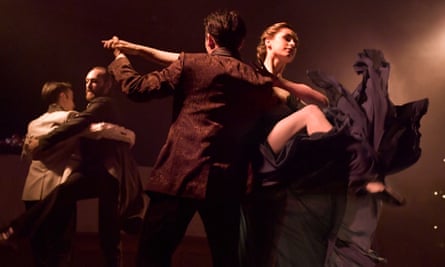The company behind The Wolf of Wall Street, the latest production to tap into the trend for immersive theatre, has introduced safeguarding measures to protect actors and participants following a series of incidents at previous high-profile shows.
The adaptation of the debauched memoir of former stockbroker and convicted fraudster Jordan Belfort opens in London this week. But the huge success of the immersive format, buoyed by its embrace of escapism and risk, has sparked concerns over how much actors are exposed to dangerous interactions with audience members.
In 2018, BuzzFeed published an expose on complaints of groping or sexual misconduct at the hit Punchdrunk production Sleep No More in New York, where 17 incidents were reported. In the same year, there were two incidents of actors being sexually assaulted at the Great Gatsby immersive show in London.
Alexander Wright, the director behind The Wolf of Wall Street and The Great Gatsby, said the latter experience gave his team a blueprint to make safe immersive theatre. “When it happened in Gatsby, we just came down very hard for the next three days,” Wright said. “At the beginning of the shows we said: ‘All right, look, this has happened to us,’ we laid out the rules and quickly made all the security systems and put them in place.”
Practices introduced by the Guild of Misrule – the company that produced The Great Gatsby and The Wolf of Wall Street – include door security, personal alarm buttons, a code-word system to flag problematic audience members, CCTV cameras, plus a safeguarding, consent and inclusion coordinator, with the overall goal being to ensure cast members are not left exposed or vulnerable. On any given performance there will be 30 staff on hand to manage the 300 audience members taking part in the show.

Wright said reminding his audience of the boundaries and “rules” was one of the most fundamental parts of the evening.
“Everyone will get a pre-show email detailing what to expect. On entry to the building, there will be signage, explaining how the rules work. And then before the show starts, everyone in small groups will go through what we call an ‘airlock’, where you move from the outside world into our world.”
It comes as Equity, the union that represents professional performers, warned about the “nightmarish” situations immersive theatre performers can find themselves in..
“We’ve heard some nightmarish cases,” Charlotte Bence, an industrial organiser at Equity, said, adding that the issue wasn’t big-budget productions such as The Wolf of Wall Street or Secret Cinema, but smaller shows that lack the resources and experience to cope with the demands of immersive theatre.
“We have examples of radios not working in massive spaces where performers are by themselves with audience members and there’s no way to get to the security. CCTV was being monitored by someone who is doing three or four jobs at the same time.”
Bence said the main problems stemmed from theatre producers – who are new to the world of immersive – not taking security seriously enough and not clearly communicating what is and isn’t acceptable to audience members.
“There’s this idea that issuing the audience with instruction then somehow it ruins the experience,” she said. “That’s where the danger is.”
Felix Barrett, founder and artistic director of Punchdrunk – one of the main companies behind the boom in immersive – said in 2013 that his immersive company was trying to “build a parallel universe” where you can forget about reality for a few hours. The Arts Council describes the sector as one that is “breaking away from established forms of theatre making and eliminating the fourth wall”.

Wright said immersive theatre was a way to test boundaries. “I believe that whatever you’re doing, you should be pushing beyond your comfort zone, or doing something which scares you,” he said.
Wright was aware of the difficulties of adapting a film in which drug abuse, sexual assault and violence is par for the course, for the stage. “There’s just no way we can do this show and fly in without thinking about that. It would be utterly reckless, and it would be an awful show.”
For some, immersive theatre is at its best when there’s an air of constructed chaos. Buy a ticket and become the star in your own experience – serviced and ushered around by a group of actors who know the right buttons to push.
During a visit to an old warehouse in the heart of the City of London, where rehearsals for the show were taking place, the Guardian was immersed in a number of imagined scenarios including boarding a plane to Switzerland with a handful of quaaludes, and running up several flights of stairs ducking FBI agents on the look out for any members of Stratton Oakmont, Belfort’s notorious stock trading company.
The debauched energy that is promised from a production sold in part as an exploration of “the extremes of capitalism and hedonistic behaviour” is something its star thinks can be harnessed. “Everything’s better on the edge,” said Ollie Tilney who plays Belfort. “You don’t get that energy on a normal stage. It can be electric. So I guess our job is to get as close to that edge as we can safely try.”
